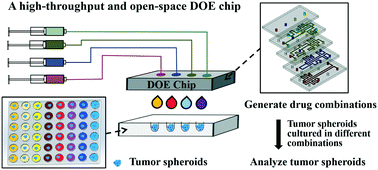A high-throughput, open-space and reusable microfluidic chip for combinational drug screening on tumor spheroids†
Abstract
Screening drug combinations using tumor spheroids can play a vital role in the development of disease treatment and personalized medicine. However, current studies focus on drug gradients or combinations of two drugs in most cases, and it is difficult to find complex therapeutic combinations involving more drugs. The use of design-of-experiment (DOE) microfluidics is a potential strategy to study this area systematically. Here we develop a high-throughput, open-space multilayered PMMA microfluidic chip for combinational drug screening on tumor spheroids. This microchip is straightforward to fabricate, compatible with standard spheroid cultures, and friendly for end-users. The device consists of an inlet layer and multiple dispersing layers. In the inlet layer, different samples can be loaded into the chip simultaneously. The sample solutions flow into the dispersing layers to generate various combinations based on the specific DOE principle. We demonstrated that the chip performance is in quantitative agreement with the design, using water and doxycycline combinations as models. As a proof-of-concept study, we constructed a HeLa reporter cell line to quantify the autophagy of tumor spheroids and used the chip to identify critical factors relating to the growth of the spheroids. Specifically, we used L-glutamine, D-glucose, FBS, and cisplatin as the factors and studied the autophagy, growth curves, and spheroid sizes in response to different combinations of the four factors. We found that D-glucose can inhibit the effects of cisplatin on tumor spheroids, and cisplatin caused severe autophagy in 3D tumor spheroids compared to 2D monoculture cells. Our method has the potential to allow more drug combinations to be examined, and it can be extended to DOE approaches with seven or more inputs.



 Please wait while we load your content...
Please wait while we load your content...